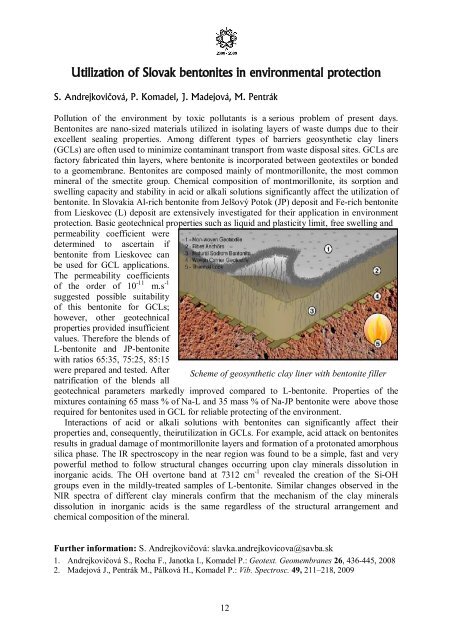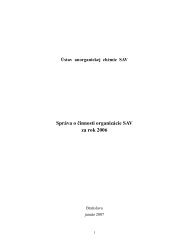Foreign Cooperating Institutions - Institute of Inorganic Chemistry ...
Foreign Cooperating Institutions - Institute of Inorganic Chemistry ...
Foreign Cooperating Institutions - Institute of Inorganic Chemistry ...
You also want an ePaper? Increase the reach of your titles
YUMPU automatically turns print PDFs into web optimized ePapers that Google loves.
Utilization <strong>of</strong> Slovak bentonites in environmental protection<br />
S. Andrejkovičová, P. Komadel, J. Madejová, M. Pentrák<br />
Pollution <strong>of</strong> the environment by toxic pollutants is a serious problem <strong>of</strong> present days.<br />
Bentonites are nano-sized materials utilized in isolating layers <strong>of</strong> waste dumps due to their<br />
excellent sealing properties. Among different types <strong>of</strong> barriers geosynthetic clay liners<br />
(GCLs) are <strong>of</strong>ten used to minimize contaminant transport from waste disposal sites. GCLs are<br />
factory fabricated thin layers, where bentonite is incorporated between geotextiles or bonded<br />
to a geomembrane. Bentonites are composed mainly <strong>of</strong> montmorillonite, the most common<br />
mineral <strong>of</strong> the smectite group. Chemical composition <strong>of</strong> montmorillonite, its sorption and<br />
swelling capacity and stability in acid or alkali solutions significantly affect the utilization <strong>of</strong><br />
bentonite. In Slovakia Al-rich bentonite from Jelšový Potok (JP) deposit and Fe-rich bentonite<br />
from Lieskovec (L) deposit are extensively investigated for their application in environment<br />
protection. Basic geotechnical properties such as liquid and plasticity limit, free swelling and<br />
permeability coefficient were<br />
determined to ascertain if<br />
bentonite from Lieskovec can<br />
be used for GCL applications.<br />
The permeability coefficients<br />
<strong>of</strong> the order <strong>of</strong> 10 -11 m.s -1<br />
suggested possible suitability<br />
<strong>of</strong> this bentonite for GCLs;<br />
however, other geotechnical<br />
properties provided insufficient<br />
values. Therefore the blends <strong>of</strong><br />
L-bentonite and JP-bentonite<br />
with ratios 65:35, 75:25, 85:15<br />
were prepared and tested. After<br />
natrification <strong>of</strong> the blends all<br />
Scheme <strong>of</strong> geosynthetic clay liner with bentonite filler<br />
geotechnical parameters markedly improved compared to L-bentonite. Properties <strong>of</strong> the<br />
mixtures containing 65 mass % <strong>of</strong> Na-L and 35 mass % <strong>of</strong> Na-JP bentonite were above those<br />
required for bentonites used in GCL for reliable protecting <strong>of</strong> the environment.<br />
Interactions <strong>of</strong> acid or alkali solutions with bentonites can significantly affect their<br />
properties and, consequently, theirutilization in GCLs. For example, acid attack on bentonites<br />
results in gradual damage <strong>of</strong> montmorillonite layers and formation <strong>of</strong> a protonated amorphous<br />
silica phase. The IR spectroscopy in the near region was found to be a simple, fast and very<br />
powerful method to follow structural changes occurring upon clay minerals dissolution in<br />
inorganic acids. The OH overtone band at 7312 cm -1 revealed the creation <strong>of</strong> the Si-OH<br />
groups even in the mildly-treated samples <strong>of</strong> L-bentonite. Similar changes observed in the<br />
NIR spectra <strong>of</strong> different clay minerals confirm that the mechanism <strong>of</strong> the clay minerals<br />
dissolution in inorganic acids is the same regardless <strong>of</strong> the structural arrangement and<br />
chemical composition <strong>of</strong> the mineral.<br />
Further information: S. Andrejkovičová: slavka.andrejkovicova@savba.sk<br />
1. Andrejkovičová S., Rocha F., Janotka I., Komadel P.: Geotext. Geomembranes 26, 436-445, 2008<br />
2. Madejová J., Pentrák M., Pálková H., Komadel P.: Vib. Spectrosc. 49, 211–218, 2009<br />
12



